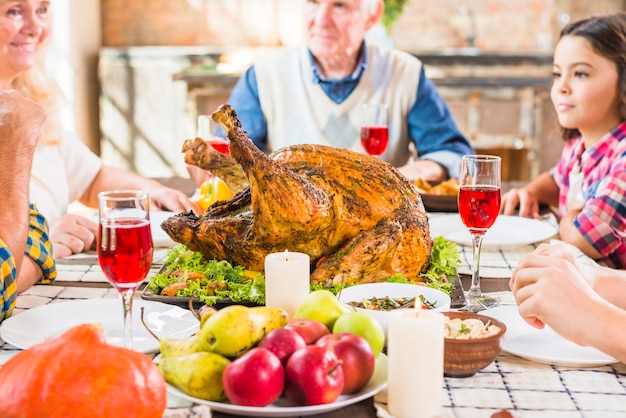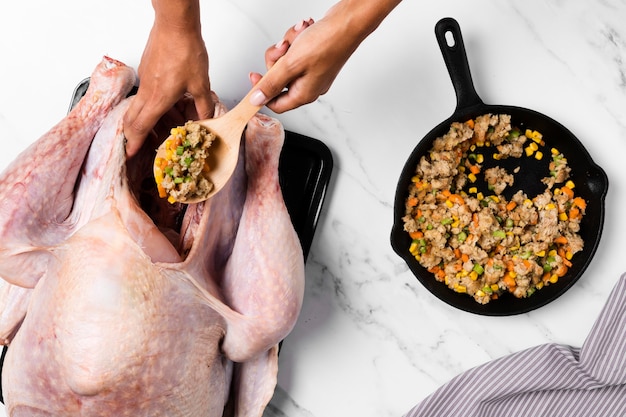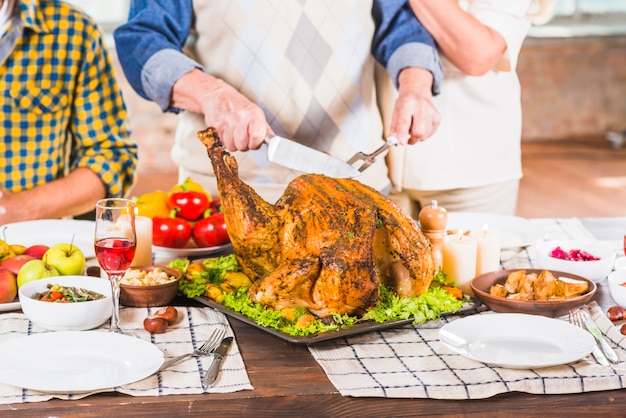Let's talk turkey, or more accurately, ground turkey! It's a lean, versatile protein that's perfect for so many dishes, from classic burgers and tacos to hearty pasta sauces and comforting chili. But, getting it cooked to perfection can feel like a gamble. Too much time, and it dries out; too little, and you've got yourself a food safety issue. I've been there, trust me!
That's why I've put together this quick guide to help you nail that perfect ground turkey every time. We'll cover everything from the right temperature to watch out for to how to tell if it's truly cooked through. So grab your apron, and let's dive in.
Part 1: Understanding the Basics

Before we get into the nitty-gritty, let's get the fundamentals straight. Ground turkey is usually sold as either "dark meat," "light meat," or a blend of both. Dark meat has more fat, which makes it juicier, but also higher in calories. Light meat is leaner, and while it's great for health-conscious eaters, it can end up dry if not cooked properly. A blend is often a happy medium, offering both flavour and moisture.
1.1. The Importance of Cooking Temperature
Here's the golden rule: ground turkey needs to reach an internal temperature of 165°F (74°C) to kill off any harmful bacteria. This applies whether you're browning it in a pan, cooking it in a casserole, or whipping up a delicious burger. It's non-negotiable for food safety!
1.2. Don't Overlook the Time Factor
While temperature is crucial, cooking time also plays a part. The amount of time it takes to cook your turkey depends on a few factors, like the quantity, the heat level, and whether you're using a pan, oven, or grill. I'll break down the specifics for each method, so you'll be a pro in no time.
Part 2: Cooking Ground Turkey in a Pan

This is the quickest and easiest way to cook ground turkey. It's my go-to when I'm short on time and need a protein fix. Here's how I do it:
2.1. Prepping for Pan-Cooking
First, grab a large skillet and heat it over medium heat. Then, add a tablespoon or two of oil or butter. This will prevent your turkey from sticking. I personally prefer to use olive oil, but you can go with whatever you fancy. Next, crumble your ground turkey into the hot skillet, making sure to break it up into small pieces. This helps it cook more evenly and gives you a nice texture.
2.2. The Cooking Process
Now, the key here is to cook the turkey without stirring it for about 5 minutes. This allows the outside to brown nicely, giving it a delicious sear that adds tons of flavor. After that, give it a good stir and continue cooking until it’s no longer pink and the juices run clear. This usually takes about 5-7 minutes, depending on the amount of turkey you're working with.
2.3. Checking for Doneness
The best way to test if it's done is to use a meat thermometer. Simply insert it into the thickest part of the turkey, making sure it doesn’t touch the pan. If it reads 165°F (74°C), you're good to go! But, if you don’t have a thermometer, you can always check for doneness by pressing on the turkey. If it feels firm and there’s no pinkness left, it's likely done. But always err on the side of caution and make sure it's fully cooked through.
2.4. Drainage
Once your turkey is cooked, you can drain off any excess fat using a slotted spoon or a colander. This is especially important if you’re using dark meat or a blend, as it can be quite greasy. I usually drain it over a paper towel-lined plate to absorb the excess fat.
2.5. Important Tip: Avoid Overcrowding the Pan
It might seem tempting to just cram all the turkey into the pan at once, but trust me, it’s better to cook it in batches if you have a large amount. This ensures that the turkey cooks evenly and doesn't end up stewing in its own juices.
Part 3: Cooking Ground Turkey in the Oven

The oven is a great option for larger batches of ground turkey, and it’s perfect for recipes like casseroles, meatloaf, and shepherd’s pie. It's a bit more hands-off than pan-cooking, which is a bonus when you're busy. Here's my approach:
3.1. Preparing for Oven Cooking
Preheat your oven to 375°F (190°C). Then, grab a large baking dish and give it a quick spray with non-stick cooking spray. This will prevent the turkey from sticking to the pan. Now, spread your ground turkey evenly in the dish and season it generously with salt and pepper. I like to add other spices, like paprika, garlic powder, or onion powder, depending on the dish I'm making. It's a great way to add some extra flavor and depth.
3.2. Cooking Time and Temperature
Pop the dish in the preheated oven and cook for about 20-25 minutes, or until the turkey reaches an internal temperature of 165°F (74°C). It’s always a good idea to check the temperature using a meat thermometer, just to be on the safe side. It's better to be safe than sorry!
3.3. Keep an Eye on the Turkey
While the turkey is cooking, keep an eye on it. You might need to stir it halfway through, especially if you're cooking a large quantity. This helps ensure even cooking and prevents any part from burning. It's worth checking in on it to make sure everything is going smoothly.
3.4. Important Tip: Don’t Overcook
Oven-cooked turkey can dry out quickly, so keep a close eye on it. Once it’s reached the right temperature, take it out of the oven and let it rest for a few minutes before using it in your recipe. This allows the juices to redistribute, making for a more tender and flavorful end product.
Part 4: Cooking Ground Turkey on the Grill
Grilling ground turkey is a delicious way to add a smoky flavor to your dishes. It's perfect for burgers, kebabs, and even tacos. It’s a great way to enjoy the outdoors and get that fantastic smoky taste. Here's my approach to grilling ground turkey:
4.1. Prepping for Grilling
Start by preheating your grill to medium heat. If you're using a gas grill, make sure all the burners are evenly lit. For charcoal grills, let the coals burn until they’re covered in ash and glowing. Then, grab a metal skewer or grilling basket and place your ground turkey on it. You can shape it into patties for burgers, or simply leave it in small balls for kebabs. Season it generously with your favorite spices, like salt, pepper, garlic powder, and onion powder.
4.2. Grilling Time and Temperature
Now, place the turkey on the hot grill and cook for 5-7 minutes per side, or until it reaches an internal temperature of 165°F (74°C). I find that a meat thermometer is essential for grilling, as it can be tricky to gauge doneness based on appearance alone. Especially with ground turkey, it can look cooked on the outside, but be undercooked in the middle.
4.3. Avoiding Flare-Ups
While grilling, watch out for flare-ups, which can happen if fat drips onto the hot coals. If you see any flames, simply move the turkey to a less hot area of the grill. You can also cover the grill with a lid for a few minutes to smother the flames. It's a good idea to keep a spray bottle of water handy for those stubborn flare-ups.
4.4. Important Tip: Don't Overcrowd the Grill
Just like with pan-cooking, don’t overcrowd the grill. Leave some space between the pieces of turkey so they cook evenly and don't steam. You might need to grill in batches, depending on the amount of turkey you're cooking. It's always better to have a few rounds of delicious, evenly cooked turkey than one big batch that's unevenly cooked.
Part 5: Using Cooked Ground Turkey
Once you've cooked your ground turkey, the possibilities are endless! It's a versatile protein that can be used in so many dishes. Here are a few of my favourite ways to use it:
5.1. Burgers
Who doesn’t love a juicy burger? To make ground turkey burgers, simply shape your cooked turkey into patties and then grill, pan-fry, or bake them. I like to top them with all the classics - cheese, lettuce, tomato, onion, pickles, and my favourite burger sauce. You can also get creative with other toppings, like avocado, bacon, or a fried egg. Let your imagination run wild!
5.2. Tacos
Ground turkey tacos are a quick and easy meal that everyone loves. Simply warm up some corn or flour tortillas, add your cooked turkey, and top with your favourite toppings. I usually go for salsa, sour cream, cheese, cilantro, and onions. You can also use other toppings, like guacamole, pico de gallo, or jalapenos, to add a bit of heat. It's a fantastic option for a weeknight dinner or a fun gathering with friends.
5.3. Pasta Sauces
Ground turkey is a fantastic base for hearty pasta sauces. You can use it to make a simple tomato sauce, or get fancy with a creamy alfredo sauce. I often add a mix of vegetables like onions, peppers, mushrooms, and spinach to my sauces. Don’t forget to season it well with herbs and spices. A little bit of fresh basil or oregano can really elevate the flavor.
5.4. Chilli
Ground turkey makes a fantastic base for a comforting chili. Simply brown the turkey in a pot, then add your favourite ingredients like beans, tomatoes, corn, and spices. I love to add a pinch of cumin, chili powder, and paprika to my chili. It’s a great way to warm up on a cold day and it’s super versatile, so you can experiment with different flavors and ingredients.
5.5. Shepherd's Pie
Shepherd’s pie is a classic comfort food that’s perfect for a cold winter night. To make it, simply layer your cooked ground turkey with a mashed potato topping. I like to add a bit of cheese to the top for extra flavor. It's a crowd-pleasing dish that's sure to warm hearts (and stomachs!).
Part 6: Making Your Ground Turkey Juicy
One of the biggest concerns with ground turkey is dryness. But, with a few simple tips, you can avoid this problem and make your turkey deliciously juicy. It's all about finding the right balance and adding a bit of moisture.
6.1. Don't Overcook
As I mentioned before, overcooking is the main culprit when it comes to dry ground turkey. Keep a close eye on the cooking time and temperature. As soon as it reaches 165°F (74°C), it’s done. Don’t cook it any longer. It’s a good idea to use a meat thermometer, as it’s the most accurate way to check for doneness.
6.2. Add Moisture
You can add moisture to your ground turkey while cooking by adding a little bit of liquid, like chicken broth, water, or wine. This helps keep the turkey moist and prevents it from drying out. Just be sure to add it gradually and don't drown your turkey! A splash is usually all it takes.
6.3. Use Fattier Ground Turkey
If you’re concerned about dryness, opt for dark meat ground turkey or a blend of light and dark meat. This will add more fat and flavor to your turkey. It's a great way to add some extra richness and juiciness to your dishes.
6.4. Add Vegetables
Adding vegetables to your ground turkey dishes can also help to add moisture and flavor. I often use onions, peppers, mushrooms, and zucchini in my recipes. Not only do they add moisture, but they also provide a boost of vitamins and minerals. It's a win-win!
Part 7: Storing and Reheating Cooked Ground Turkey
Once you’ve cooked your ground turkey, it’s important to store it properly to ensure freshness and prevent spoilage. It's always best to use it as soon as possible, but if you need to store it, here's how to do it right:
7.1. Refrigeration
Once your ground turkey has cooled down to room temperature, transfer it to an airtight container and store it in the refrigerator for up to 3-4 days. It's best to use it within this timeframe for optimal quality. It's always a good idea to label the container with the date so you know how long it's been in the fridge.
7.2. Freezing
You can also freeze cooked ground turkey for up to 2-3 months. To freeze, simply place it in a freezer-safe container or bag. Make sure to squeeze out as much air as possible before sealing the bag to prevent freezer burn. To thaw frozen turkey, transfer it to the refrigerator overnight.
7.3. Reheating
You can reheat cooked ground turkey on the stovetop, in the oven, or in the microwave. I prefer to reheat it on the stovetop with a little bit of liquid to keep it moist. If you’re using the oven, preheat it to 350°F (175°C) and bake the turkey for 15-20 minutes. For the microwave, heat it in 30-second intervals until it’s heated through. Just be sure to heat it thoroughly to kill off any bacteria.
Part 8: FAQs
I know, I know, you're probably wondering a few things. So, here are some of the most frequently asked questions about cooking ground turkey:
8.1. Can I cook ground turkey from frozen?
Technically, you can cook ground turkey from frozen, but it will take longer and it might not cook evenly. I always recommend thawing it in the refrigerator overnight before cooking for the best results. It's a bit more work upfront, but it's worth it for a better, more evenly cooked product.
8.2. What’s the difference between ground turkey and ground chicken?
Ground turkey and ground chicken are both lean proteins, but they have different flavour profiles. Ground turkey tends to be milder and more delicate, while ground chicken has a stronger, more chicken-y flavour. It really comes down to personal preference, so try both and see which one you prefer.
8.3. Is ground turkey good for you?
Yes, ground turkey is a good source of protein and several essential nutrients. It’s also lower in fat and calories than ground beef. But, it’s important to choose lean ground turkey and avoid overcooking it to ensure it stays juicy and delicious. It's a healthy and tasty option that can fit into a variety of diets.
8.4. How can I tell if ground turkey is spoiled?
Spoiled ground turkey will have an off-putting smell and a slimy texture. If you notice any of these signs, it’s best to discard the turkey. It’s always a good idea to check the expiration date on the package as well. It's better to be safe than sorry, especially when it comes to food safety.
8.5. Can I add spices to ground turkey while cooking?
Absolutely! Adding spices to ground turkey while cooking is a great way to enhance its flavour. You can use your favourite spices, like salt, pepper, paprika, garlic powder, onion powder, cumin, chili powder, or oregano. Just be sure to add them towards the end of cooking, so they don’t burn. It's a great way to personalize your dishes and add some extra depth of flavor.
Part 9: Final Thoughts
Well, there you have it, a comprehensive guide to cooking ground turkey. I hope this has helped clear up any questions you had and empowered you to cook delicious, juicy, and safe ground turkey dishes. Just remember the golden rule: cook it to 165°F (74°C), and don’t overcook it. Happy cooking, and enjoy your delicious ground turkey creations!
Everyone is watching

Corn on the Cob: The Ultimate Guide to Perfectly Cooked Ears
Healthy MealsAh, corn on the cob. Just the name evokes images of sunny days, barbecues, and that sweet, juicy flavour that ...

Scallops: The Ultimate Guide to Perfect Cooking
Healthy MealsAh, scallops. Those delicate, sweet, and utterly delicious morsels of the sea. They hold a special place in my...

Spaghetti Squash: The Ultimate Guide to Cooking and Serving
Healthy MealsRemember that time you saw spaghetti squash at the supermarket, looking all bumpy and strange, and thought, "W...

Salmon Cooking Times: Perfect Guide for Every Recipe
Healthy MealsLet me tell you, cooking salmon is an art form. It's all about getting that perfect balance: juicy and tender,...

Ham Cooking Time: How Long to Bake, Smoke, or Boil a Delicious Ham
Healthy MealsAh, ham. It's a classic, isn't it? A real crowd-pleaser, especially around holidays. And when done right, it'...
